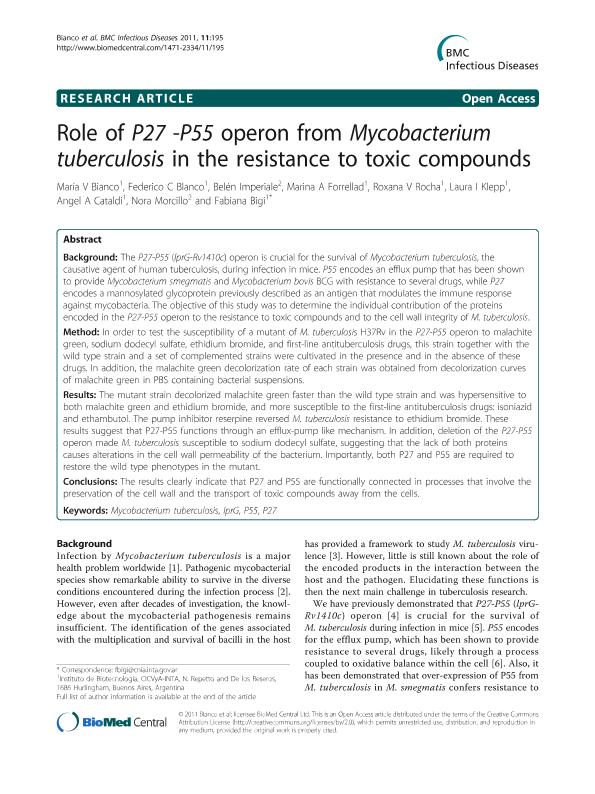Artículo
Role of P27 -P55 operon from Mycobacterium tuberculosis in the resistance to toxic compounds
Bianco, María V.; Blanco, Federico Carlos ; Imperiale, Belén Rocío
; Imperiale, Belén Rocío ; Forrellad, Marina Andrea
; Forrellad, Marina Andrea ; Rocha, Roxana V.; Klepp, Laura Ines
; Rocha, Roxana V.; Klepp, Laura Ines ; Cataldi, Angel Adrian
; Cataldi, Angel Adrian ; Morcillo, Nora Susana; Bigi, Fabiana
; Morcillo, Nora Susana; Bigi, Fabiana
 ; Imperiale, Belén Rocío
; Imperiale, Belén Rocío ; Forrellad, Marina Andrea
; Forrellad, Marina Andrea ; Rocha, Roxana V.; Klepp, Laura Ines
; Rocha, Roxana V.; Klepp, Laura Ines ; Cataldi, Angel Adrian
; Cataldi, Angel Adrian ; Morcillo, Nora Susana; Bigi, Fabiana
; Morcillo, Nora Susana; Bigi, Fabiana
Fecha de publicación:
07/2011
Editorial:
BioMed Central
Revista:
BMC Infectious Diseases
ISSN:
1471-2334
Idioma:
Inglés
Tipo de recurso:
Artículo publicado
Clasificación temática:
Resumen
Background: The P27-P55 (lprG-Rv1410c) operon is crucial for the survival of Mycobacterium tuberculosis, the causative agent of human tuberculosis, during infection in mice. P55 encodes an efflux pump that has been shown to provide Mycobacterium smegmatis and Mycobacterium bovis BCG with resistance to several drugs, while P27 encodes a mannosylated glycoprotein previously described as an antigen that modulates the immune response against mycobacteria. The objective of this study was to determine the individual contribution of the proteins encoded in the P27-P55 operon to the resistance to toxic compounds and to the cell wall integrity of M. tuberculosis.Method: In order to test the susceptibility of a mutant of M. tuberculosis H37Rv in the P27-P55 operon to malachite green, sodium dodecyl sulfate, ethidium bromide, and first-line antituberculosis drugs, this strain together with the wild type strain and a set of complemented strains were cultivated in the presence and in the absence of these drugs. In addition, the malachite green decolorization rate of each strain was obtained from decolorization curves of malachite green in PBS containing bacterial suspensions.Results: The mutant strain decolorized malachite green faster than the wild type strain and was hypersensitive to both malachite green and ethidium bromide, and more susceptible to the first-line antituberculosis drugs: isoniazid and ethambutol. The pump inhibitor reserpine reversed M. tuberculosis resistance to ethidium bromide. These results suggest that P27-P55 functions through an efflux-pump like mechanism. In addition, deletion of the P27-P55 operon made M. tuberculosis susceptible to sodium dodecyl sulfate, suggesting that the lack of both proteins causes alterations in the cell wall permeability of the bacterium. Importantly, both P27 and P55 are required to restore the wild type phenotypes in the mutant.Conclusions: The results clearly indicate that P27 and P55 are functionally connected in processes that involve the preservation of the cell wall and the transport of toxic compounds away from the cells.
Palabras clave:
MYCOBACTERIUM TUBERCULOSISL
,
P27
,
P55
,
PRG
Archivos asociados
Licencia
Identificadores
Colecciones
Articulos(SEDE CENTRAL)
Articulos de SEDE CENTRAL
Articulos de SEDE CENTRAL
Citación
Bianco, María V.; Blanco, Federico Carlos; Imperiale, Belén Rocío; Forrellad, Marina Andrea; Rocha, Roxana V.; et al.; Role of P27 -P55 operon from Mycobacterium tuberculosis in the resistance to toxic compounds; BioMed Central; BMC Infectious Diseases; 11; 7-2011; 1-9
Compartir
Altmétricas



